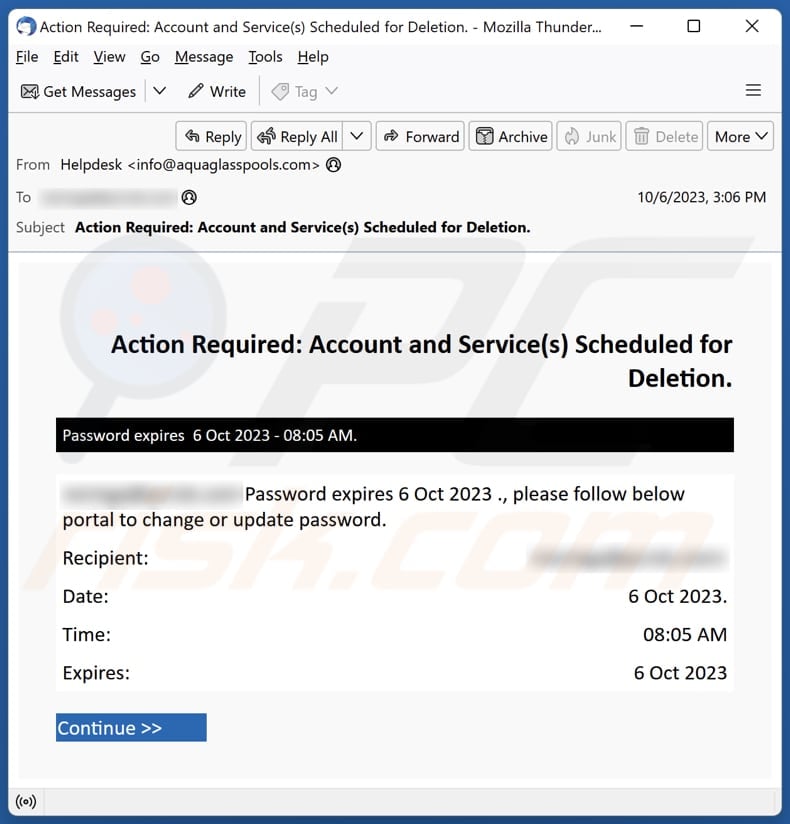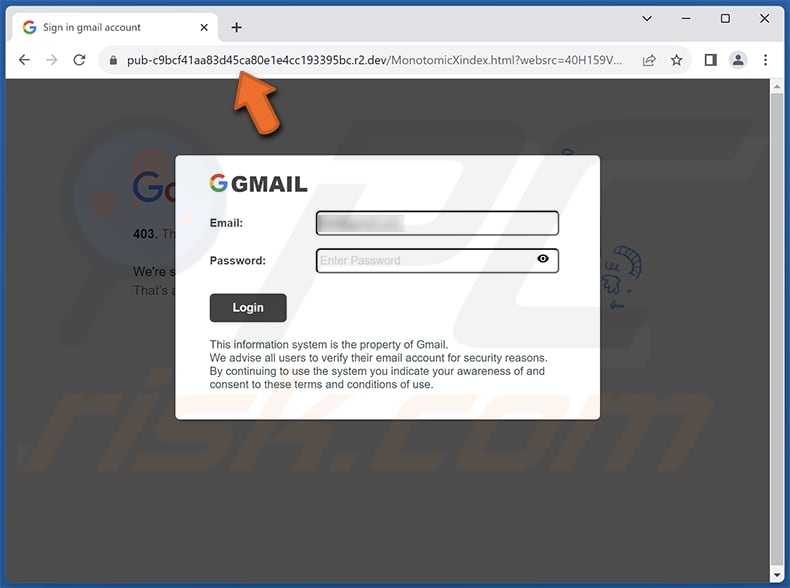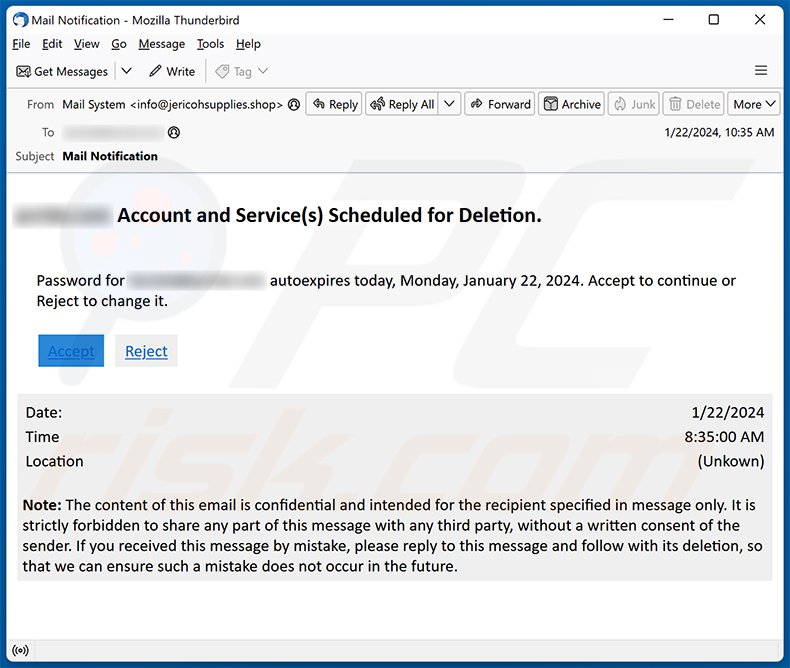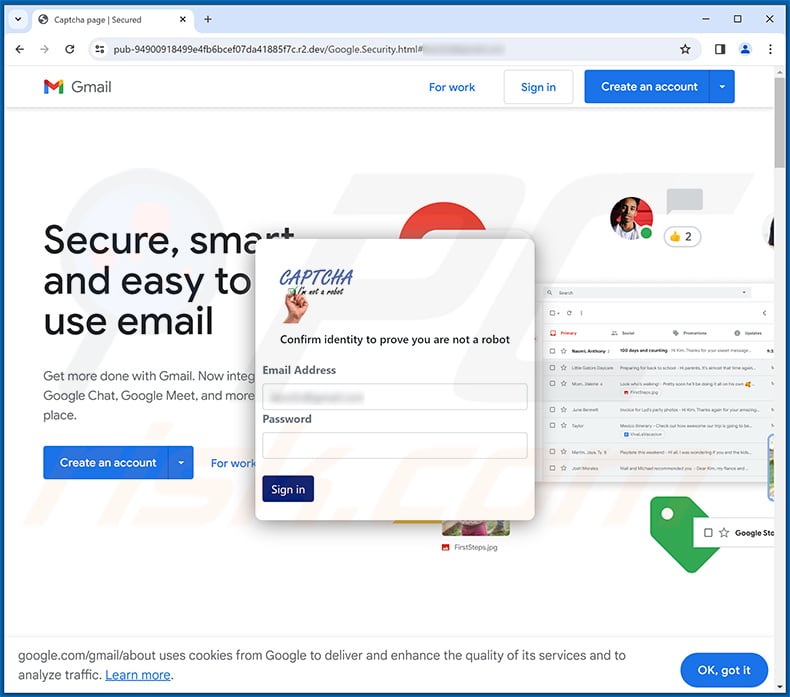How to spot phishing emails like "Account And Service(s) Scheduled For Deletion"
![]() Written by Tomas Meskauskas on (updated)
Written by Tomas Meskauskas on (updated)
What is "Account And Service(s) Scheduled For Deletion"?
Upon review, it has been confirmed that this email is a phishing scam. The individuals orchestrating this fraudulent scheme aim to trick recipients into revealing sensitive information on a deceptive website. Therefore, it is strongly recommended to ignore this email and avoid responding to it.

More about the "Account And Service(s) Scheduled For Deletion" scam email
In the phishing email, the recipient is informed that their account and associated services are allegedly scheduled for deletion. The email claims that the recipient's password is set to expire on the specified time and date. It urges the recipient to follow a provided link to change or update their password.
The email specifies the recipient's name, the date, and the time of the supposed password expiration. It includes a "Continue >>" link designed to trick the recipient into clicking on it and revealing sensitive information. The provided button opens a fraudulent sign-in page that closely mimics the official website, altering its appearance to resemble the recipient's email service provider.
For instance, if the recipient utilizes Gmail, the deceptive page will replicate the Gmail sign-in portal. The objective of this counterfeit page is to entice unwary users into divulging their email account login details, such as email addresses and passwords.
Criminals can employ stolen email account login details in a variety of detrimental ways. These credentials can grant them unauthorized entry to the victim's private and sensitive data, encompassing emails, contact information, and documents. This pilfered information can then be exploited for fraudulent activities like identity theft.
Furthermore, scammers can leverage the compromised email account to initiate phishing endeavors, dispatching malevolent emails to the victim's contacts or employing the account to propagate fraudulent schemes further. Additionally, they may endeavor to reset passwords for other online accounts linked to the victim's email address, potentially gaining unauthorized access to more accounts.
Moreover, malevolent actors may seek to infiltrate additional accounts using obtained login credentials. Finally, the stolen credentials may be traded on the dark web, contributing to a broader network of cybercriminal activities.
| Name | Account And Service(s) Scheduled For Deletion Email Scam |
| Threat Type | Phishing, Scam, Social Engineering, Fraud |
| Fake Claim | Recipient's email account and associated services are scheduled for deletion |
| Disguise | Letter from an email service provider |
| Symptoms | Unauthorized online purchases, changed online account passwords, identity theft, illegal access of the computer. |
| Distribution methods | Deceptive emails, rogue online pop-up ads, search engine poisoning techniques, misspelled domains. |
| Damage | Loss of sensitive private information, monetary loss, identity theft. |
| Malware Removal (Windows) | To eliminate possible malware infections, scan your computer with legitimate antivirus software. Our security researchers recommend using Combo Cleaner. |
Similar emails in general
Phishing emails employ tactics aimed at misleading recipients. This can involve assuming the identity of reputable organizations such as banks, government institutions, or well-known websites. Typically, such emails employ tactics that induce a sense of urgency or alarm to compel recipients to act swiftly, asserting that their account is compromised or emphasizing the need for immediate attention due to a time-sensitive matter.
Scammers behind these emails often seek sensitive data, such as passwords, credit card details, or social security numbers. It is important to note that they may incorporate hyperlinks to malicious websites or attachments designed to inject harmful software.
Examples of such emails are "HR Department Shared A File With You Email Scam", "A New Sign-In On Windows Email Scam", and "A Payment Has Been Posted On Your Card Email Scam".
How do spam campaigns infect computers?
Users can accidentally infect their computers through email in several ways. One way is by opening attachments that can contain malware, compromising the computer's security. Another way is by enabling macros in email attachments, which can also lead to an infection. Lastly, clicking on malicious links in emails can redirect users to harmful websites that introduce malware to the system.
How to avoid installation of malware?
To steer clear of malware, exercise caution with email attachments and links, especially if the sender is unknown or the email appears suspicious. Refrain from clicking on advertisements from untrustworthy sources and avoid visiting dubious websites.
Maintain the security of your computer by consistently updating the operating system, applications, and web browsers. When downloading files or software, rely solely on reliable sources, such as official websites and app stores.
If you have already opened malicious attachments, we recommend running a scan with Combo Cleaner Antivirus for Windows to automatically eliminate infiltrated malware.
Text presented in the "Account And Service(s) Scheduled For Deletion" email letter:
Action Required: Account and Service(s) Scheduled for Deletion.
Password expires 6 Oct 2023 - 08:05 AM.
********* Password expires 6 Oct 2023 ., please follow below portal to change or update password.
Recipient:
Date: 6 Oct 2023.
Time: 08:05 AM
Expires: 6 Oct 2023
Continue >>
Screenshot of the phishing website masquerading as the Gmail sign-in page:

Another example of an email from "Account And Service(s) Scheduled For Deletion" spam campaign:

Text presented within:
Subject: Mail Notification
******** Account and Service(s) Scheduled for Deletion.
Password for ******** autoexpires today, Monday, January 22, 2024. Accept to continue or Reject to change it.
Accept Reject
Date: 1/22/2024
Time 8:35:00 AM
Location (Unkown)
Screenshot of the promoted phishing site:

Instant automatic malware removal:
Manual threat removal might be a lengthy and complicated process that requires advanced IT skills. Combo Cleaner is a professional automatic malware removal tool that is recommended to get rid of malware. Download it by clicking the button below:
▼ DOWNLOAD Combo Cleaner
By downloading any software listed on this website you agree to our Privacy Policy and Terms of Use. To use full-featured product, you have to purchase a license for Combo Cleaner. 7 days free trial available. Combo Cleaner is owned and operated by Rcs Lt, the parent company of PCRisk.com read more.
Quick menu:
- What is Account And Service(s) Scheduled For Deletion phishing scam?
- Types of malicious emails.
- How to spot a malicious email?
- What to do if you fell for an email scam?
Types of malicious emails:
![]() Phishing Emails
Phishing Emails
Most commonly, cybercriminals use deceptive emails to trick Internet users into giving away their sensitive private information, for example, login information for various online services, email accounts, or online banking information.
Such attacks are called phishing. In a phishing attack, cybercriminals usually send an email message with some popular service logo (for example, Microsoft, DHL, Amazon, Netflix), create urgency (wrong shipping address, expired password, etc.), and place a link which they hope their potential victims will click on.
After clicking the link presented in such email message, victims are redirected to a fake website that looks identical or extremely similar to the original one. Victims are then asked to enter their password, credit card details, or some other information that gets stolen by cybercriminals.
![]() Emails with Malicious Attachments
Emails with Malicious Attachments
Another popular attack vector is email spam with malicious attachments that infect users' computers with malware. Malicious attachments usually carry trojans that are capable of stealing passwords, banking information, and other sensitive information.
In such attacks, cybercriminals' main goal is to trick their potential victims into opening an infected email attachment. To achieve this goal, email messages usually talk about recently received invoices, faxes, or voice messages.
If a potential victim falls for the lure and opens the attachment, their computers get infected, and cybercriminals can collect a lot of sensitive information.
While it's a more complicated method to steal personal information (spam filters and antivirus programs usually detect such attempts), if successful, cybercriminals can get a much wider array of data and can collect information for a long period of time.
![]() Sextortion Emails
Sextortion Emails
This is a type of phishing. In this case, users receive an email claiming that a cybercriminal could access the webcam of the potential victim and has a video recording of one's masturbation.
To get rid of the video, victims are asked to pay a ransom (usually using Bitcoin or another cryptocurrency). Nevertheless, all of these claims are false - users who receive such emails should ignore and delete them.
How to spot a malicious email?
While cyber criminals try to make their lure emails look trustworthy, here are some things that you should look for when trying to spot a phishing email:
- Check the sender's ("from") email address: Hover your mouse over the "from" address and check if it's legitimate. For example, if you received an email from Microsoft, be sure to check if the email address is @microsoft.com and not something suspicious like @m1crosoft.com, @microsfot.com, @account-security-noreply.com, etc.
- Check for generic greetings: If the greeting in the email is "Dear user", "Dear @youremail.com", "Dear valued customer", this should raise suspiciousness. Most commonly, companies call you by your name. Lack of this information could signal a phishing attempt.
- Check the links in the email: Hover your mouse over the link presented in the email, if the link that appears seems suspicious, don't click it. For example, if you received an email from Microsoft and the link in the email shows that it will go to firebasestorage.googleapis.com/v0... you shouldn't trust it. It's best not to click any links in the emails but to visit the company website that sent you the email in the first place.
- Don't blindly trust email attachments: Most commonly, legitimate companies will ask you to log in to their website and to view any documents there; if you received an email with an attachment, it's a good idea to scan it with an antivirus application. Infected email attachments are a common attack vector used by cybercriminals.
To minimise the risk of opening phishing and malicious emails we recommend using Combo Cleaner Antivirus for Windows.
Example of a spam email:

What to do if you fell for an email scam?
- If you clicked on a link in a phishing email and entered your password - be sure to change your password as soon as possible. Usually, cybercriminals collect stolen credentials and then sell them to other groups that use them for malicious purposes. If you change your password in a timely manner, there's a chance that criminals won't have enough time to do any damage.
- If you entered your credit card information - contact your bank as soon as possible and explain the situation. There's a good chance that you will need to cancel your compromised credit card and get a new one.
- If you see any signs of identity theft - you should immediately contact the Federal Trade Commission. This institution will collect information about your situation and create a personal recovery plan.
- If you opened a malicious attachment - your computer is probably infected, you should scan it with a reputable antivirus application. For this purpose, we recommend using Combo Cleaner Antivirus for Windows.
- Help other Internet users - report phishing emails to Anti-Phishing Working Group, FBI’s Internet Crime Complaint Center, National Fraud Information Center and U.S. Department of Justice.
Frequently Asked Questions (FAQ)
Why did I receive this email?
Scammers send identical letters to a large number of people, aiming for even one person to take the bait. These spam emails are usually devoid of personalization and exhibit a highly generic nature.
I have provided my personal information when tricked by this email, what should I do?
If scammers have illicitly acquired your email account login details, it is crucial to act swiftly. Begin by altering the passwords for all accounts where you have used the same login information, particularly those related to financial or sensitive data. Additionally, promptly notify your email service provider about the security breach.
I have downloaded and opened a malicious file attached to this email, is my computer infected?
The likelihood of infection is notably greater when dealing with executable files (.exe). However, with file types such as .pdf or .doc, there is a possibility that simply opening these documents may not lead to an infection, as certain malware might not have the capability to compromise your computer through this action alone.
I have read the email but did not open the attachment, is my computer infected?
Simply opening an email is typically considered safe, as it does not inherently present any immediate risk. The potential for system infections arises when users actively engage with the email, such as by clicking on embedded links or opening attached files.
Will Combo Cleaner remove malware infections that were present in email attachment?
Combo Cleaner can remove the majority of well-known malware infections. Nevertheless, advanced malware has the capability to hide deeply within the system. Hence, it is advisable to perform a comprehensive system scan to guarantee the detection and eradication of such threats.


▼ Show Discussion